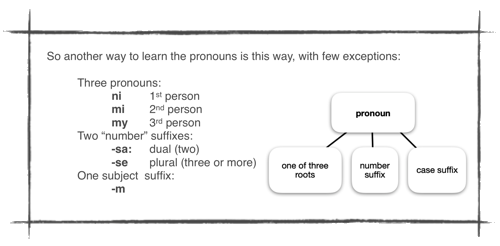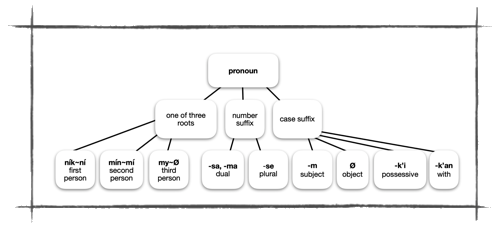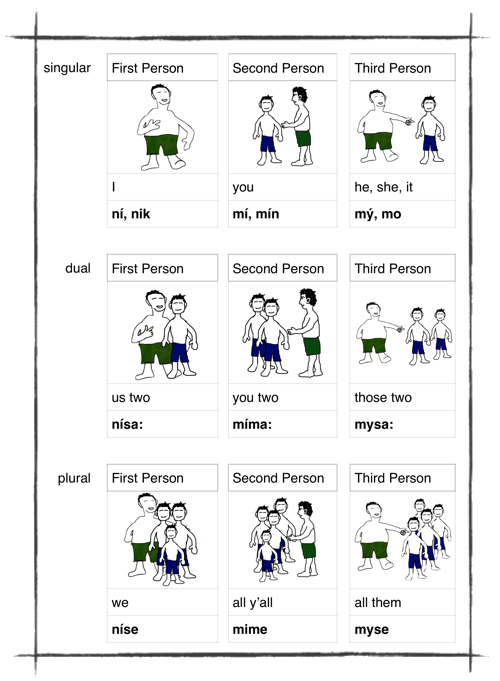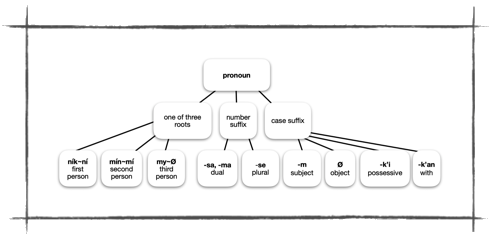These are the vocabulary words that will be introduced in this lesson.
Pronouns are words like “I,” “me” (first person); “you” (second person); and “he, him, she, her, it” (third person). And of course there are the plural pronouns like “we”, “us,” “they” and “them”. That’s how they work in English.
However, Konkow does have a very rich pronoun system. We will start by showing you the subject and object pronouns. Examine the chart below.

THREE pronouns
- ní 1st person
- mí 2nd person
- mý 3rd person
TWO number suffixes
- -sa: dual (two)
- -se plural (three or more)
ONE subject suffix
- -m
The exceptions are these:
- ní is the 1st person singular subject, don’t add ‑m to it.
- mí is the 2nd person singular subject, don’t add ‑m to it.
- ník is the 1st person singular object, so unlike all the other pronouns, you add -k.
- mín is the 2nd person singular object, so unlike all other pronouns, you add -n.


Using the English translation as your guide, put the correct pronouns in the following sentences. Say the sentences out loud, too, for practice. (We aren’t separating all the components of each word, but you should recognize a few components here and there.
Place these pronouns into the sentences below.
nik - nìsa - mỳm - mínaj - mímem - ni mý
sólmanc’os.
He must have sung.
màko: wótiminc’ehàj, t’akì:n
If you plural catch the fish, I will roast it.
(both of these pronouns are subjects.)
-màja:s hémnon.
We two are reading.
kànaj méjin.
I gave it to you alone.
néno jántop!
Tell me a story!
mỳm sólmanc’os.
He must have sung.
mímem màko: wótiminc’ehàj, ni mý t’akì:n
If you plural catch the fish, I will roast it.
(both of these pronouns are subjects.)
nìsa-màja:s hémnon.
We two are reading.
mínaj kànaj méjin.
I gave it to you alone.
néno ník jántop!
Tell me a story!
Here are some examples from the Lost Swimmer:
As you saw earlier in this lesson there are several suffixes that are added to pronouns. We learned about the three roots and the suffixes for dual and plural. For the subjective case an -m is added. For the objective case the pronoun root is simply used. There are two additional suffixes we would like to call attention to here with pronouns that end with -k’i (possessive) and ones that end with -k’an (with).

Examples of the -k’i (possessive) and -k’an (with) suffixes on pronouns:
-k'an
-k'i
-k'(i)
Fill in the appropriate pronoun in the phrases and sentences below.
mýepà:
‘their (plural) mothers’
té:k’i c’ibi:
‘her cub’s claws’.
mìhámmano Ɂýko:n.
You ought to have gone with him.
Ɂámamàde Ɂújimàn ?
Is that your house?
Ɂánte, pèma Ɂámamàn.
But of course, that’s my food!
mýse:k’i mýepà:
‘their (plural) mothers’
mýk’i té:k’i c’ibi:
‘her cub’s claws’.
mìhámmano mỳk’an Ɂýko:n.
You ought to have gone with him.
Ɂámamàde mínk’i Ɂújimàn ?
Is that your house?
Ɂánte, ník’i pèma Ɂámamàn.
But of course, that’s my food!
Here’s an example from Coyote and the Turtle Girls: Coyote sees the Turtle Girls swimming, and asks “How is the water?” They respond “It’s fine.” So then Coyote says:
Examples:
These are more common than the plain subject pronouns because they are more emphatic. So we see again, that pronouns are primarily used for emphasis.

Using the Konkow vocabulary you know, along with pronouns, write a short story. How many of the pronouns from this chapter can you use?
Fill in the blank spaces with the Konkow pronoun
Replace each underlined
noun phrase with the appropriate
pronoun
Example: mímem
Are you and Hank going hang-gliding?
As for all lessons, to really learn from this lesson you need to practice it and use it. Practice composing sentences of your own, using these pronouns and the vocabulary you have learned so far. Do the flashcard activities or use them in your own ways. Now that you know how to say “I” did something, you could start keeping a diary, where you write a sentence or two about your day.
- ní 1st person
- mí 2nd person
- mý 3rd person
- -sa: dual (two)
- -se plural (three or more)
- -m subject
- -k’i possessive
- -k’an with (someone)
- ∅ object is indicated by having no suffix
- ní is the 1st person singular subject, don’t add ‑m to it.
- mí is the 2nd person singular subject, don’t add ‑m to it.
- ník is the 1st person singular object, so unlike all the other pronouns, you add -k.
- mín is the 2nd person singular object, so unlike all other pronouns, you add -n.
Want to learn more? All the Mary Jones videos lessons are available HERE
